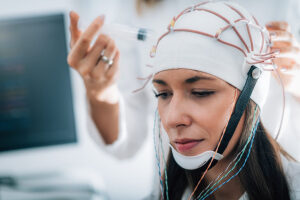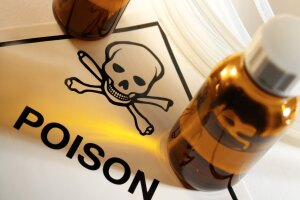Dieser Beitrag ist auch verfügbar auf:
Deutsch
Suppose we could manipulate our genes. Or what if our dreams revealed more about our illnesses than any doctor? What was long considered esoteric nonsense can now be scientifically proven. And so one of the biggest paradigm shifts in the history of medicine is currently underway …
The force of the impact is devastating – as is the doctors’ prognosis: after Morris Goodman has to make an emergency landing in his single-engine Cessna 172, the aircraft overturns several times. Rescue workers retrieve his body from the completely destroyed wreckage of the plane. At this point, the 35-year-old can only blink. Two neck vertebrae are shattered, dozens of bones broken, organs shredded. According to the doctors, Goodman will never be able to walk again, let alone talk, eat or drink on his own. A nursing case for life – if he doesn’t succumb to his injuries in the next few days.
What they don’t know is that the moment he is admitted to hospital, his mind is already working at full speed. “Even though I couldn’t move a muscle, I felt extreme willpower in every fiber of my body. I was convinced that I would get better,” recalls Goodman. And indeed, just five months after the accident, the American leaves the clinic. In good health and standing on his own two feet. Today he flies around the world, gives lectures – and explains how you can harness the incredible power of thought for yourself…
Bridging the gap between mysticism and psychology
But was Morris Goodman perhaps just incredibly lucky? Or are thoughts actually more powerful than we previously assumed? And if so, how can we use them for our health? Dr. Lissa Rankin, US physician and bestselling author (“Mind over Medicine”), has addressed precisely these questions. She has evaluated thousands of studies, conducted interviews with patients and analyzed their healing processes. She is convinced: “In everyday clinical practice, we doctors repeatedly encounter things that simply cannot be explained scientifically. We know that inexplicable spontaneous healings occasionally occur. And deep down, most doctors are convinced that a bridge between the mystical and the physiological plays a role in the recovery process. But no one says this out loud.”
The fact is, however, that although hardly any targeted research has been carried out, more than 1,000 cases have been scientifically recorded today in which supposedly incurable diseases have spontaneously disappeared. And almost all cases had one thing in common: those affected reported extreme willpower and positive thoughts, which they used as a weapon against the disease. But what exactly happens during these mysterious self-healing processes in the body? In fact, for many doctors, cases like Morris Goodman’s are not a miracle, but the result of a complex system of regeneration through the power of our thoughts.
As Jerome Groopman, a physician at Harvard University, explains: “Thoughts and emotions are often regarded as secondary in medicine. In reality, however, they are nothing more than a mixture of chemicals and electrical circuits in the brain that develop and change.” In other words, everything we think is not a metaphysical spook that somehow wafts around between our cells.
It is an integral part of our body, measurable and verifiable. If, for example, muscles are not moved for a longer period of time, as in the case of Morris Goodman, who was involved in the accident, they regress. To prevent this, researchers at Ohio University have developed a process in which muscles are regenerated using only the power of thought. A motorized action is not necessary. How does it work? Imagination!
Can my thoughts cure cancer?
If you imagine moving the muscle (through sport) for 15 minutes a day for twelve weeks, the regions in the brain responsible for movement are stimulated – and the muscle is restored. Another example of the power of thought is the spontaneous healing of tumor patients. Cancerous tumors contain nerve fibers and are therefore connected to the brain and the central nervous system.
The researchers therefore assume that the psyche can intervene in the development of tumors. And in the immune system. This is because every sensation releases messenger substances in the brain – the body’s own drugs that have an analgesic effect, for example. Every thought activates nerve impulses that penetrate the tumor.
Studies show that patients who firmly believe in their recovery produce significantly more immune cells. However, this uncanny power of thought can best be observed in the context of placebo studies, i.e. in comparison with drug-free therapies. For example, almost half of asthmatics can achieve an improvement in their symptoms with a drug-free inhaler, and around 40 percent of headache patients respond positively to a placebo.
And a knee surgery study by Dr. Bruce Moseley shows that even sham surgery can be just as effective as real surgery. The surgeon had developed a special surgical method for patients with osteoarthritis of the knee joint. The patients of one group were operated on according to Dr. Moseley’s well-known procedure. The subjects in the other group underwent a complex simulated procedure. The knee problems were corrected as expected in a third of the test subjects who actually underwent surgery, but the result was just as good in the patients who only underwent sham surgery.
When the survival mechanism kicks in
But how can it be explained that thoughts, feelings and expectations can be reflected in physiological changes? As Harvard professor Dr. Walter Cannon was the first to describe, the body has what Cannon calls a stress response (often called the fight-or-flight response): a survival mechanism that kicks in when our brain senses a threat.
If this hormonal cascade is triggered by a thought or feeling such as fear, the body is flooded with cortisol and adrenaline. If the level of these stress hormones is elevated for a longer period of time, this can manifest itself in physical symptoms and make the body susceptible to illness.
But our body also has a relaxation response. When this is triggered, the level of stress hormones in the blood decreases and health-promoting relaxation hormones are released. “Only in this relaxed state can the body repair itself. So anything that reduces stress and triggers a relaxation response enables it to heal itself,” says Lissa Rankin.






